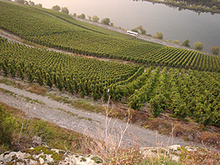
Moselle wine is produced in three countries along the river Moselle: France, Luxembourg (the Musel) and Germany (the Mosel). Moselle wines are mainly white and are made in some of the coldest climates used for commercial winemaking.

Moselle wine is produced in three countries along the river Moselle: France, Luxembourg (the Musel) and Germany (the Mosel). Moselle wines are mainly white and are made in some of the coldest climates used for commercial winemaking.
In France, in Lorraine around the city of Metz, about 1500 hectoliters of wine annually is produced as AOC Moselle. These wines together with Côtes de Toul make up the 200 hectares of "wines of the east" (vins de l'Est). [1] [2] The most commonly grown grape varieties are Auxerrois Blanc and Müller-Thurgau, and the other allowed varieties are Gamay, Gewürztraminer, Meunier, Pinot noir, Pinot blanc, Pinot gris and Riesling. Previously, the name "Vins de Moselle" was used, between 1995 and 2010 the official name was VDQS Moselle. [3] As the area under vine is very small, these wines are seldom seen on the export market.
In southeastern Luxembourg, along the country's 42 km river border with Germany, 1 290 hectares of vines are used to produce wine under the designation Appellation Contrôlée Moselle Luxembourgeoise. [4] Common varieties and their proportion of vineyard area in 2002 are Müller-Thurgau (usually under the name Rivaner) at 31.4%, Auxerrois blanc (13.1%), Riesling (12.9%), Pinot gris (12.7%), Elbling (10.9%), Pinot blanc (10.5%), Pinot noir (6.2%), Gewürztraminer (1.1%) and Chardonnay (0.9%). [5] Rivaner and Elbling are on the decline, and while Riesling is usually considered the premier variety wherever it is grown, in Luxembourg Auxerrois tends to be considered as the most successful variety. Luxembourg wines in general have been described as lighter-style Alsace wine but are not very often encountered outside Luxembourg and neighbouring Belgium as most of the production tends to be consumed by the Luxembourgers themselves.
Sparkling wine (Crémant de Luxembourg) makes up a significant portion of the production, but is a designation within AC Moselle Luxembourgeoise rather than a separate appellation, which is usually the case with French Crémants.
Mosel is one of 13 German wine-growing regions (Anbaugebiete) for quality wines, with 9 080 hectares under vine in 2005, and one of the most well-known. The region also includes vineyards situated on the Saar and Ruwer rivers. The main varieties are Riesling (57.7% in 2005), Müller-Thurgau (15.0%), Elbling (6.6%) and Kerner (4.9%). High-quality Mosel wine is synonymous with Riesling, and most of the Elbling ends up in non-varietally labelled Sekt (sparkling wine).

Sparkling wine is a wine with significant levels of carbon dioxide in it, making it fizzy. While it is common to refer to this as champagne, European Union countries legally reserve that word for products exclusively produced in the Champagne region of France. Sparkling wine is usually either white or rosé, but there are examples of red sparkling wines such as the Italian Brachetto, Bonarda and Lambrusco, and the Australian sparkling Shiraz. The sweetness of sparkling wine can range from very dry brut styles to sweeter doux varieties.

Pinot blanc or Pinot bianco is a white wine grape. It is a point genetic mutation of Pinot noir. Pinot noir is genetically unstable and will occasionally experience a point mutation in which a vine bears all black fruit except for one cane which produces white fruit.

Mosel is one of 13 German wine regions (Weinbaugebiete) for quality wines , and takes its name from the Mosel River. Before 1 August 2007 the region was called Mosel-Saar-Ruwer, but changed to a name that was considered more consumer-friendly. The wine region is Germany's third largest in terms of production but some consider it the leading region in terms of international prestige.
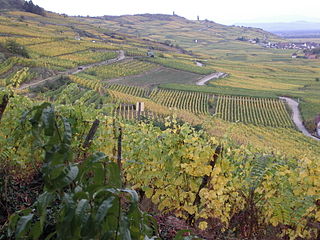
Alsace wine or Alsatian wine is produced in the Alsace region in France and is primarily white wine. Because of its Germanic influence, it is the only Appellation d'Origine Contrôlée region in France to produce mostly varietal wines, typically from similar grape varieties to those used in German wine. Along with Austria and Germany, it produces some of the most noted dry Rieslings in the world as well as highly aromatic Gewürztraminer wines. Wines are produced under three different AOCs: Alsace AOC for white, rosé and red wines, Alsace Grand Cru AOC for white wines from certain classified vineyards and Crémant d'Alsace AOC for sparkling wines. Both dry and sweet white wines are produced.
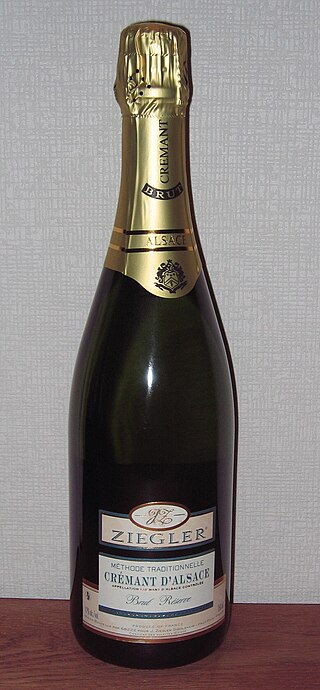
Crémant d'Alsace is an Appellation d'Origine Contrôlée for sparkling wines made in the Alsace wine region of France. Produced since 1900, the CréCrémant regulated by the European Parliament in 1996.
Côtes de Toul is an Appellation d'Origine Contrôlée (AOC) for French wine produced in the département of Meurthe-et-Moselle in the Lorraine région. The Côtes de Toul vineyards cover 110 hectares in an area close to Toul, to the west of the city of Nancy. The area of production includes the following communes: Blénod-lès-Toul, Bruley, Bulligny, Charmes-la-Côte, Domgermain, Lucey, Mont-le-Vignoble and Pagney-derrière-Barine. Annual production is 4,500 hectoliters, corresponding to 600,000 bottles.
Luxembourg's cuisine reflects the country's position between the Latin and Germanic countries, influenced by the cuisines of neighbouring France, Belgium and Germany. Recently, it has been influenced by the country's many Italian and Portuguese immigrants. As in Germany, most traditional, everyday Luxembourg dishes are of peasant origin, in contrast to the more sophisticated French fare.

Auxerrois blanc or Auxerrois Blanc de Laquenexy is a white wine grape prevalent in the French region of Alsace, and is also grown in neighbouring Germany and Luxembourg. It is a full sibling of Chardonnay that is often blended with the similar Pinot blanc.

Luxembourgish wine is primarily produced in the southeastern part of the Grand Duchy of Luxembourg, with vineyards overlooking the river Moselle. Along this river, which for 42 km makes up part of the border between Luxembourg and Germany, wine is made in three countries. There is a continuous history of winemaking along Moselle and in Luxembourg going back to Ancient Roman times. Wine production in 2006/07 was 123,652 hectoliter from 1,237 hectares of vineyards. Out of total wine exports of 87,776 hectoliter in 2005/06, 71,726 hectoliter or 82% was exported to nearby Belgium. Exports to Germany were the second largest at 8,168 hectoliter, or 9%, and is to a large extent made up of base wine in bulk for the production of blended Sekt rather than being sold bottled with "Luxembourg" anywhere on the label. Therefore, very little Luxembourgish wine is seen outside Luxembourg and Belgium.
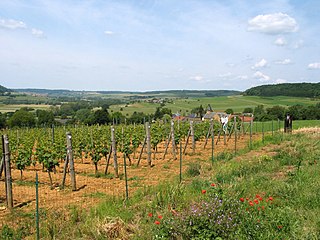
Belgian wine is produced in several parts of Belgium and production, although still modest at 1,400 hectoliters in 2004, has expanded in recent decades.
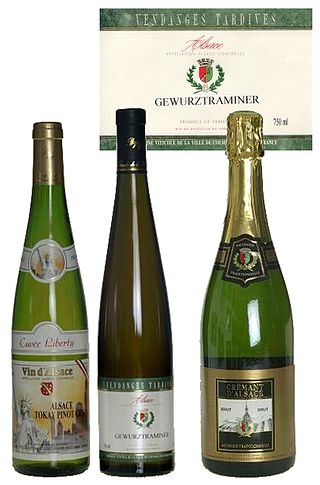
The wine region of Alsace produces wines under three different Appellations d'Origine Contrôlées (AOCs): Alsace AOC for white, rosé and red wines, Alsace Grand Cru AOC for white wines from certain classified vineyards and Crémant d'Alsace AOC for sparkling wines. This region is the only French wine region allowed to label its wines based on variety.

Dutch wine is wine made in the Netherlands. Although a small producer of wine, it is nowadays a strong growing branch of Dutch agriculture. Currently, the country has 180 commercial vineyards.

The Upper Moselle is the section of the River Moselle, 45 kilometres long, that runs from the Franco-German-Luxembourg tripoint near Perl to its confluence with the Saar near Konz shortly before Trier. From the tripoint to its confluence with the Sauer, the Upper Moselle forms the border between the German states of the Saarland and Rhineland-Palatinate on the one side and Luxembourg on the other. This stretch of the river known as the Upper Moselle is, however, not the same as the geographical upper reaches of the Moselle, which run from its source near Bussang in the Vosges mountains in Lorraine via Épinal and Nancy roughly as far as Metz.
The Alsace Grand Cru Hengst, or Hengst, is a French wine originating in the commune of Wintzenheim, in the département of Haut-Rhin, in Alsace. While historically almost solely made up by white wines, a small amount of production is now Grand Cru red wine, solely from Pinot Noir grapes.

Alsace Grand Cru Altenberg de Bergheim, or Altenberg-de-Bergheim is a French white wine produced in the Altenberg lieu-dit, located in the commune of Bergheim, in the Haut-Rhin department, in Alsace.

Alsace Grand Cru Brand is a French white wine produced in the Haut-Rhin department, in Alsace.

Bruderthal is an Alsace Grand Cru French white wine from the village of Molsheim produced in the Bas-Rhin department, in Alsace.

Alsace Grand Cru Eichberg is a French white wine produced in the Haut-Rhin department, in Alsace. On the Alsace Wine Route, Eichberg is located six kilometres southwest of Colmar. In terms of the Alsace vineyards it lies between Pfersigberg to the north and Hatschbourg to the south. It is one of the fifty-one grands crus of the Alsace region, each enjoying its own appellation but sharing the same Alsace Grand Cru specifications.
Alsace Grand Cru ‘’Engelberg’’ is a French white wine produced in the Bas-Rhin department, in Alsace.

Alsace Grand Cru Floriment is a French white wine produced in the Haut-Rhin department, in Alsace. It is a part of the communes of Ingersheim and Katzenthal.